
Jan van Eyck was a Flemish painter active in Bruges who was one of the early innovators of what became known as Early Netherlandish painting, and one of the most significant representatives of Early Northern Renaissance art. According to Vasari and other art historians including Ernst Gombrich, he invented oil painting, though most now regard that claim as an oversimplification.

Hubert van Eyck or Huybrecht van Eyck was an Early Netherlandish painter and older brother of Jan van Eyck, as well as Lambert and Margareta, also painters. The absence of any single work that he can clearly be said to have completed continues to make an assessment of his achievement highly uncertain, although for centuries he had the reputation of being an outstanding founding artist of Early Netherlandish painting.

The Ghent Altarpiece, also called the Adoration of the Mystic Lamb, is a very large and complex 15th-century polyptych altarpiece in St Bavo's Cathedral, Ghent, Belgium. It was begun around the mid-1420s and completed by 1432, and it is attributed to the Early Netherlandish painters and brothers Hubert and Jan van Eyck. The altarpiece is a prominent example of the transition from Middle Age to Renaissance art and is considered a masterpiece of European art, identified by some as "the first major oil painting."

Robert Campin, now usually identified with the Master of Flémalle, was a master painter who, along with Jan van Eyck, initiated the development of Early Netherlandish painting, a key development in the early Northern Renaissance.

Art theft, sometimes called artnapping, is the stealing of paintings, sculptures, or other forms of visual art from galleries, museums or other public and private locations. Stolen art is often resold or used by criminals as collateral to secure loans. Only a small percentage of stolen art is recovered—an estimated 10%. Many nations operate police squads to investigate art theft and illegal trade in stolen art and antiquities.
Michiel Coxie the Elder, Michiel Coxcie the Elder or Michiel van Coxcie, Latinised name Coxius, was a Flemish painter of altarpieces and portraits, a draughtsman and a designer of stained-glass windows, tapestries and prints. He worked for patrons in the principal cities of Flanders. He became the court painter to successively Emperor Charles V and King Philip II of Spain.
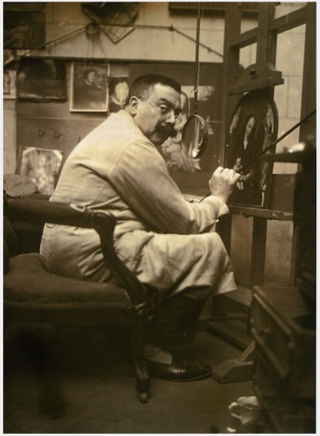
Josephus Maria Van der Veken was a Belgian art restorer, copyist, and art forger who mastered the art of reproducing the works of early Netherlandish painters.
The Just Judges, also called The Righteous Judges, is the lower left panel of the Ghent Altarpiece, painted by Jan van Eyck or his brother Hubert Van Eyck between 1430 and 1432. It is believed that the panel shows portraits of several contemporary figures such as Philip the Good, and possibly the artists Hubert and Jan van Eyck themselves. The panel was stolen in 1934 and has never been found.
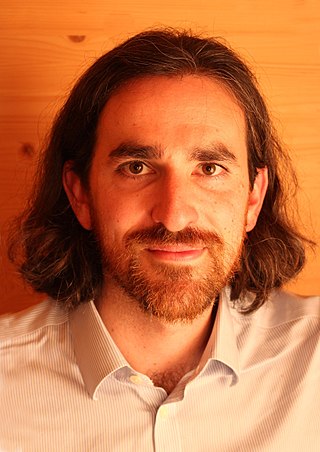
Noah Charney is an American art historian and novelist based in Slovenia. He is the author of The Art Thief, a mystery novel about a series of thefts from European museums and churches, and is the founder of the Association for Research into Crimes against Art.
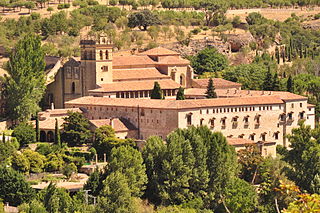
Monastery of Saint Mary of Parral is a Roman Catholic monastery of the enclosed monks of the Order of Saint Jerome just outside the walls of Segovia, Spain.
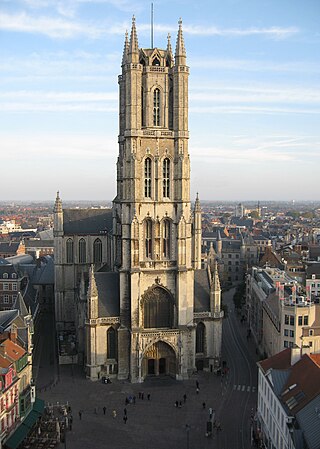
Saint Bavo's Cathedral, also known as Sint-Baafs Cathedral, is a cathedral of the Catholic Church in Ghent, Belgium. The 89-meter-tall Gothic building is the seat of the Diocese of Ghent and is named for Saint Bavo of Ghent. It contains the well-known Ghent Altarpiece.
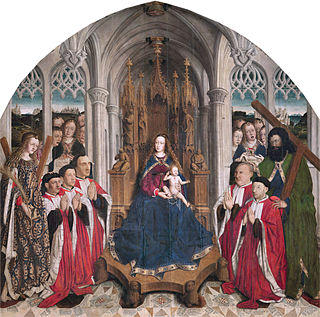
Lluís Dalmau was a Spanish-Valencian painter. He was active in Barcelona from 1428 to 1460 and served the king of Spain in an official capacity. In 1431, King Alfonso V sent him to Flanders to learn the language of realist painting. He made a copy of the Adoration of the Lamb by Hubert and Jan van Eyck; in 1432, this was placed in St Bavo's Cathedral, Ghent. The next year, he had returned to Barcelona. In 1443, Dalmau was commissioned to paint the Virgin of the Consellers altarpiece for the chapel of the City Hall, which he completed in 1445; this is perhaps the only known work of his to survive. In 1445, he also painted a Virgin and Child in the style of Jan van Eyck, which is in the church of San Miguel at Barcelona.
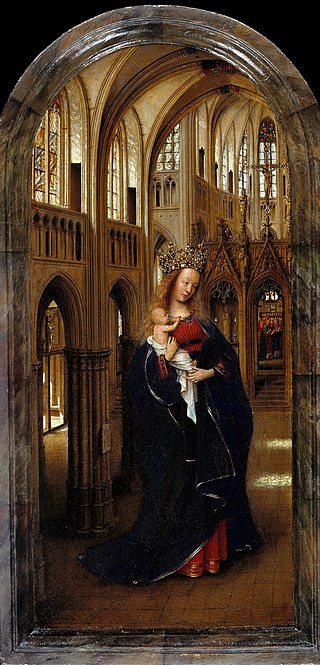
Madonna in the Church is a small oil panel by the early Netherlandish painter Jan van Eyck. Probably executed between c. 1438–1440, it depicts the Virgin Mary holding the Child Jesus in a Gothic cathedral. Mary is presented as Queen of Heaven wearing a jewel-studded crown, cradling a playful child Christ who gazes at her and grips the neckline of her red dress in a manner that recalls the 13th-century Byzantine tradition of the Eleusa icon. Tracery in the arch at the rear of the nave contains wooden carvings depicting episodes from Mary's life, while a faux bois sculpture in a niche shows her holding the child in a similar pose. Erwin Panofsky sees the painting composed as if the main figures in the panel are intended to be the sculptures come to life. In a doorway to the right, two angels sing psalms from a hymn book. Like other Byzantine depictions of the Madonna, van Eyck depicts a monumental Mary, unrealistically large compared to her surroundings. The panel contains closely observed beams of light flooding through the cathedral's windows. It illuminates the interior before culminating in two pools on the floor. The light has symbolic significance, alluding simultaneously to Mary's virginal purity and God's ethereal presence.

Saint Barbara is a small 1437 drawing on oak panel, signed and dated 1437 by the Netherlandish artist Jan van Eyck. It is unknown if the work is a chalk ground study in pencil for a planned oil painting, an unfinished underdrawing or a completed work in of itself, although the latter is deemed more likely. The panel shows Saint Barbara imprisoned in a tower by her pagan father to preserve her from the outside world, especially from suitors he did not approve of. While there, she converted to Christianity, enraging her father and leading to her murder and martyrdom.
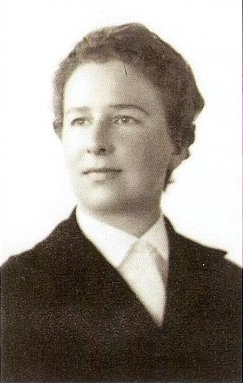
Elisabeth Dhanens was a Belgian art historian specialising in Early Netherlandish painting. Dhanens studied art history at Ghent University at the Higher Institute of Art, where she earned a Ph.D in 1945. Her dissertation was a monograph on the early-16th century artist Jan van Roome, published in 1948. From 1945 to 1952 Dhanens was a researcher in Brussels at the Royal Institute for Cultural Heritage, where she worked in the documentation laboratory. From 1952 to 1976 she held a position as art inspector in East Flanders's Art Patrimony, where she collected inventories from churches for the government. Based on field work in Italy in the early 1950s she published a monograph about Jean Boulogne in 1956, which earned her an award from the Royal Flemish Academy of Sciences, Letters and Fine Arts and a year later a Fulbright scholarship - allowing her to study in the United States.

The Fountain of Life or The Fountain of Grace and the Triumph of the Church over the Synagogue are names given to an oil on panel painting completed c 1432. For most of its history the painting has been in Spain, latterly in the Museo del Prado which recently featured it in a special exhibition. Stylistically and thematically, the painting is related to the work of Jan van Eyck, but it is unsigned and there have been competing theories as to whether it is by van Eyck himself.

Honoré Jozef Coppieters was a Belgian prelate who became, in 1927, the Bishop of Ghent.
The German Nazi Party looted and stole art, gold and other objects that had been either plundered or moved for safekeeping at various storage sites during World War II. These sites included salt mines at Altaussee and Merkers and a copper mine at Siegen.

Victor Lagye was a Belgian painter and illustrator best known for his genre paintings and history scenes. He participated in various decorative programs commissioned by the Belgian government. In his later years he was active in art education.















